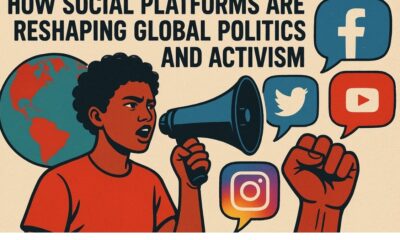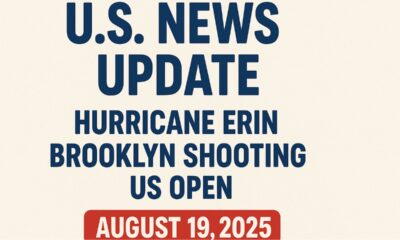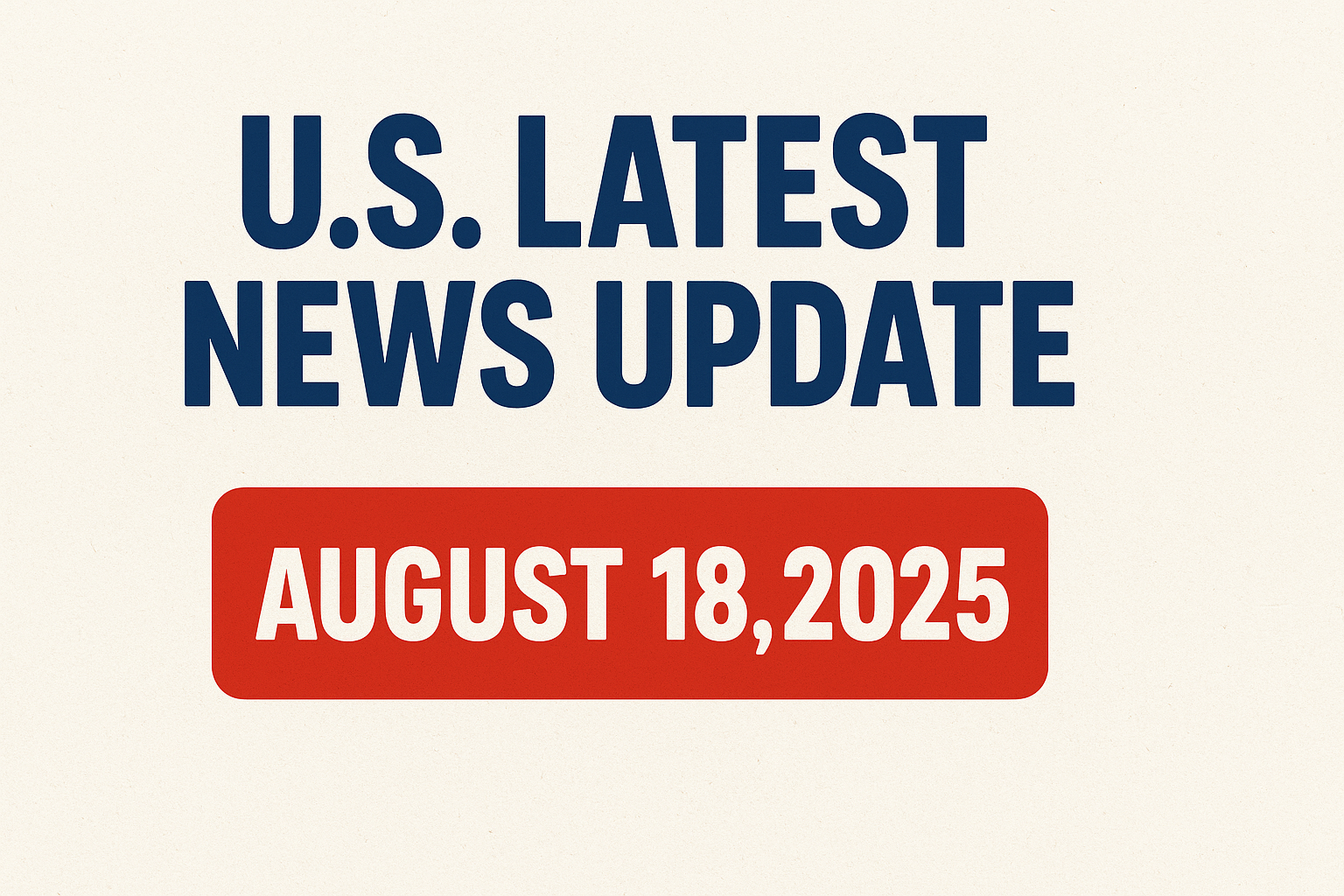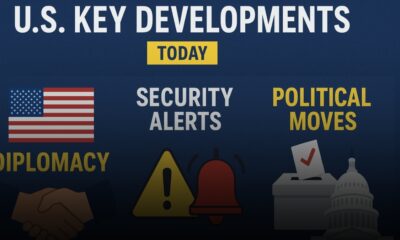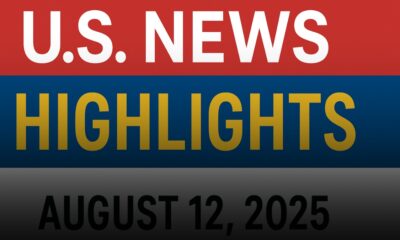Entertainment
U.S. Flagged Over Civil Liberties as Fed Holds Rates | July 30 News Recap
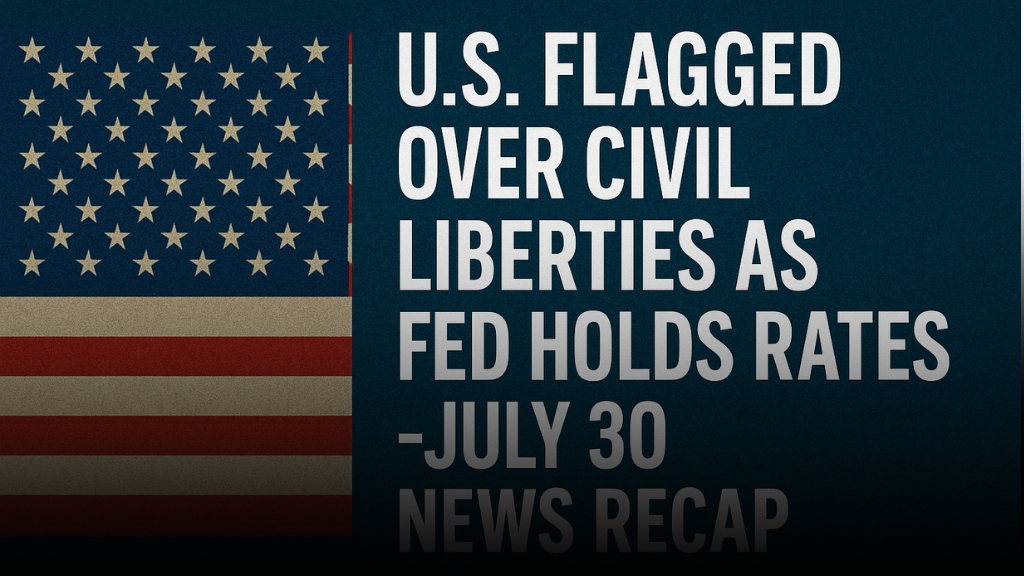
On July 30, 2025, the United States made global headlines—not for its economy or foreign policy—but for being formally added to a civil liberties watchlist maintained by CIVICUS, a respected global human rights organization. On the same day, the Federal Reserve announced it would hold interest rates steady, reflecting uncertainty over inflation and the strength of Q2 economic growth.
This dual news cycle paints a complex picture of a country at the intersection of political pressure, economic fragility, and civil liberty challenges.
U.S. Added to CIVICUS Global Watchlist
What Happened?
CIVICUS, the global civil society monitor, updated its mid-year report and added the United States to its “narrowed civic space” category—a designation reserved for countries where democratic freedoms are increasingly restricted.
Key Allegations:
- Deployment of federal troops against peaceful protestors in Los Angeles and New York
- Systematic suppression of independent journalists and civic organizers
- Political defunding of public broadcasting networks and NGOs
- Introduction of state-level laws limiting protests and assembly
Why This Watchlist Matters
The CIVICUS Watchlist is regarded as a barometer for global democratic health. Countries listed often face scrutiny from the UN, international watchdogs, and human rights courts.
For the U.S., traditionally seen as a beacon of free expression, this designation is highly significant—especially under President Donald Trump’s second term, which has seen growing criticism over authoritarian tactics.
“The U.S. no longer meets basic global standards for civic freedom,” the CIVICUS report stated.
“This decline has serious implications for domestic civil society and global democratic credibility.”
Federal Reserve Holds Interest Rates Steady
In a separate but equally critical development, the Federal Reserve decided to hold interest rates during its July 30 meeting. The decision came despite strong Q2 GDP growth and internal debate over the pace of inflation control.
Key Economic Signals:
- Q2 GDP growth exceeded forecasts: 2.9%–3.1%
- Core inflation remains stubbornly high
- Tariffs and trade policies contributed to mixed investor sentiment
- Fed Chair Jerome Powell emphasized “caution” as the guiding principle
Political Context and Economic Dissonance
The coincidence of these two stories—human rights regression and financial stagnation—points to a broader theme: internal instability.
| Area | Crisis Element |
|---|---|
| Civic Freedoms | Widespread crackdown on protests and the free press |
| Economy | Uncertain inflation, cautious Fed, growing class division |
| Public Sentiment | Eroding trust in both government institutions |
Global Reactions and Media Coverage
- BBC News reported on the CIVICUS announcement, highlighting how the U.S. joins countries like India, Hungary, and Brazil in the “narrowed” category.
- CNN and TIME focused on the political implications of labeling the U.S. as regressive on civil rights.
- Reuters and Investors.com explored the Fed’s balancing act, weighing growth against inflation pressures.
Expert Opinions
Dr. Laura Simmons, a political analyst at Harvard Kennedy School, said:
“America is now confronting a legitimacy crisis—domestically and internationally. This watchlist placement is not just symbolic—it’s a warning.”
Meanwhile, economist Jeremy Xu commented:
“The Fed’s neutral stance shows uncertainty, not strength. Inflation is persistent, and political disruption is clouding the outlook.”
Public and Social Media Reactions
Social platforms exploded with hashtags like:
- #CivicCrisis
- #FedStalls
- #DemocracyAlert
Advocacy groups announced campaigns to pressure Congress and the courts to roll back new protest-limiting laws and restore public funding for journalism.
Frequently Asked Questions (FAQs)
1. What is the CIVICUS Watchlist?
It’s a global report highlighting countries where civic freedoms like protest, media freedom, and civil society participation are under threat.
2. Why was the U.S. added in July 2025?
Due to documented crackdowns on peaceful protestors, suppression of the press, and political moves to dismantle public accountability systems.
3. Did President Trump respond to the listing?
No official response yet, though administration officials have dismissed previous rights reports as “politically motivated.”
4. How did the economy perform in Q2 2025?
The U.S. GDP grew above expectations (~3%), but inflation remains high, prompting the Fed to hold rates.
5. What does this mean for average Americans?
Higher inflation may persist longer, and civil rights organizations warn of growing restrictions on freedom of speech and assembly.
6. What’s next for U.S. policy?
Expect more legal challenges from rights groups and cautious moves from financial institutions until stability returns.
Conclusion
The July 30, 2025, news cycle paints a sobering picture of a nation facing dual pressures—one legal, one economic. As the U.S. joins a global watchlist for civil liberty erosion and the Fed tightens its grip on monetary policy, the message is clear:
Freedom and stability are being tested.
America’s path forward will depend not only on leadership but on the resilience of its institutions and the engagement of its people.
Entertainment
U.S. Key Developments | Today | Diplomacy, Security Alerts, and Political Moves

August 15, 2025, brought a series of significant developments in U.S. foreign policy, domestic politics, and security concerns. From high-profile summits with global leaders to emerging political strategies and security alerts, these events reflect America’s shifting role in international diplomacy while managing critical issues at home.
1. Trump–South Korea Summit Scheduled for August 25
The White House confirmed that President Donald Trump will host South Korean President Lee Jae Myung in Washington on August 25.
Focus Areas:
- Strengthening economic cooperation in semiconductors and energy transition
- Expanding defense ties in response to regional security threats
- Joint initiatives in advanced manufacturing and technology
This summit marks a crucial step in reinforcing U.S. alliances in the Indo-Pacific, particularly amid growing competition with China.
2. Trump–Putin Summit in Alaska on Ukraine Crisis
In a surprising diplomatic move, President Trump and Russian President Vladimir Putin will meet in Alaska to discuss the ongoing war in Ukraine.
Key Discussion Points:
- A potential territorial exchange to resolve the conflict
- Sanctions relief in exchange for verifiable security guarantees
- Russia’s role in broader global energy markets
This meeting has generated both optimism and skepticism, with analysts debating whether a lasting peace can be achieved.
3. U.S. Independence Day Greetings to India and Pakistan
The Biden administration delivered carefully crafted diplomatic messages for both India’s and Pakistan’s Independence Days.
- To India (August 15): A warm congratulatory note emphasizing democratic values and mutual security interests.
- To Pakistan (August 14): A more pragmatic message, focusing on cooperation in critical minerals and energy sectors.
This demonstrates Washington’s nuanced balancing act between two historical rivals in South Asia.
4. California’s Special Election on U.S. House Redistricting
Governor Gavin Newsom has called for a special election to redraw congressional maps in California.
Reason for the Move:
- Countering Republican-led redistricting efforts in Texas
- Protecting equitable political representation
- Addressing concerns over gerrymandering and voter fairness
This political development could set a precedent for other states facing similar challenges.
5. Bomb Threat at U.S. Embassy in Seoul
On South Korea’s Liberation Day, the U.S. Embassy in Seoul faced a bomb threat traced to a known hoax perpetrator.
Investigation Findings:
- No explosives found
- The alias used matched prior false alarm incidents
- Authorities emphasized vigilance and enhanced digital security monitoring
While no harm was caused, the event underscored the ongoing security challenges faced by U.S. diplomatic facilities abroad.
U.S. Developments on August 15, 2025
| Event | Key Details |
|---|---|
| Trump–South Korea Summit | Scheduled for Aug 25; focus on trade, technology, and security |
| Trump–Putin Summit | Talks on Ukraine peace and global energy markets |
| U.S. Independence Day Messages | Warm greeting to India; economic focus with Pakistan |
| California Redistricting Election | Special vote to redraw maps, counter Texas political strategies |
| Seoul Embassy Bomb Threat | False alarm; investigation highlights cyber-security threats |
Political and Strategic Implications
The timing of these events reflects the U.S. government’s multi-pronged approach to international relations:
- Diplomatic Engagement: Engaging both allies and adversaries to shape global outcomes.
- Domestic Safeguards: Protecting democratic processes through electoral fairness.
- Security Vigilance: Balancing cyber and physical security in a complex threat environment.
Conclusion
August 15, 2025, was a defining day for U.S. diplomacy and domestic politics. The announced summits, political maneuvers, and security alerts highlight the nation’s active role in shaping global developments while safeguarding democratic institutions at home. As these events unfold, their outcomes will likely influence both the 2025 political landscape and America’s international standing.
Entertainment
U.S. Tariff Truce | Heatwave | and Political Shifts
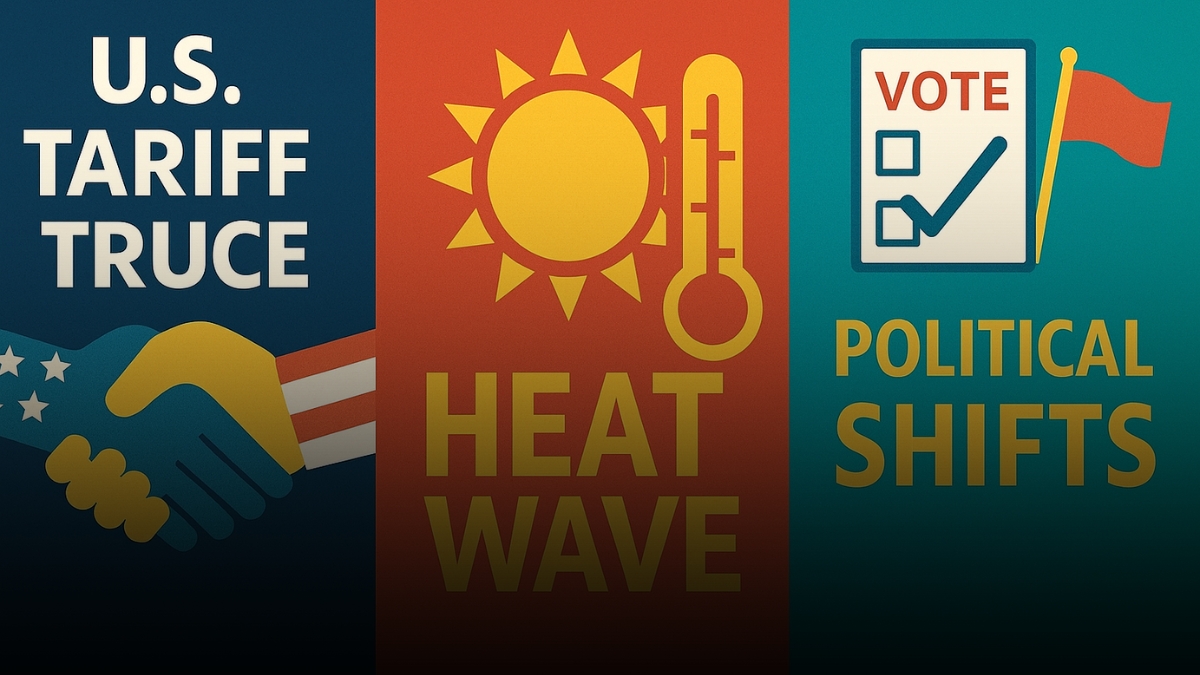
1. Tariff Truce Extended for 90 Days
The United States and China have agreed to extend their current tariff truce by another 90 days, preventing sharp increases in trade duties. This extension is intended to maintain stable trade conditions ahead of the holiday shopping season and has provided a boost to global market confidence.
2. New BLS Chief Picked Amid Data Integrity Debate
President Trump has nominated economist E.J. Antoni, affiliated with the conservative Heritage Foundation, as the new commissioner of the Bureau of Labor Statistics. The move comes after the unexpected dismissal of the previous commissioner and has sparked discussion over the potential politicization of U.S. economic data.
3. Intense Heatwave Spreads Across U.S.
A severe heatwave is affecting large parts of the United States, with the East Coast experiencing record-breaking highs across New England and the Mid-Atlantic. In the West, temperatures have soared above 110 °F, prompting health warnings and raising wildfire risks. Authorities caution that extreme heat conditions may persist.
4. South Africa Prepares Revised Trade Pitch
In response to heavy U.S. tariffs, South Africa is finalizing a revised trade proposal aimed at lowering the 30% duty imposed on many of its exports. The move seeks to reinvigorate stalled trade negotiations between the two countries.
August 12 Key U.S. Developments
| Topic | Key Insight |
|---|---|
| Tariff Truce Extended | U.S. and China delay tariff hikes by 90 days, calming markets |
| New BLS Nomination | Antoni chosen amid concerns over independence of official economic statistics |
| Nationwide Heatwave | Record-breaking temperatures raise public health and wildfire concerns |
| South Africa Trade Offer | Revised deal proposal aims to ease U.S. tariff pressure on exports |
Key Takeaways
- Trade Stability: The 90-day tariff extension offers breathing space for businesses while keeping the door open for further negotiations.
- Economic Data Oversight: The appointment of E.J. Antoni has stirred political debate about the credibility and independence of government-reported economic data.
- Climate Impacts: The ongoing heatwave highlights the intensifying effects of climate change and the need for improved emergency response systems.
- Global Diplomacy: South Africa’s revised trade bid underscores the impact of U.S. trade policy on emerging economies and the importance of maintaining open dialogue.
Entertainment
U.S. News Highlights | August 12, 2025

August 12, 2025, brought significant developments in U.S. economic policy, foreign diplomacy, energy markets, and domestic governance. From trade negotiations easing global tensions to planned strategic security talks, the day showcased America’s influence on both international and local fronts.
2. U.S.–China Tariff Truce Extended
The United States and China agreed to extend their existing tariff truce by 90 days, preventing a major escalation in import duties. This move comes as both sides seek to protect economic stability ahead of peak trading seasons.
Economic Impact:
- Avoids tariff hikes that could have affected billions in goods.
- Provides businesses with breathing space for supply chain adjustments.
- Signals potential for renewed high-level negotiations between the United States and China.
Details Table:
| Aspect | Information |
|---|---|
| Duration | 90 days |
| Purpose | Prevent tariff escalation |
| Markets Reaction | Positive – stocks and oil prices rose |
| Trade Volume Impact | Stabilization expected |
3. Asian Markets Respond Positively
Global investors reacted with optimism to the tariff extension. Japan’s stock market hit record highs, while other Asian markets posted steady gains.
Market Drivers:
- Technology sector growth.
- Weak Australian interest rates are supporting investment.
- Confidence in U.S.–China trade stability.
Details Table:
| Market | Reaction |
|---|---|
| Japan Nikkei Index | Record high |
| Hong Kong Hang Seng | Moderate gains |
| Shanghai Composite | Slight increase |
4. Oil Prices Climb on Trade Relief
Crude oil prices rose as easing trade tensions reduced fears of global demand disruptions. Investors also looked ahead to upcoming U.S. inflation data and the Trump–Putin summit.
Price Overview:
- Brent crude: modest increase.
- WTI crude: mirrored Brent’s gains.
Details Table:
| Factor | Impact on Oil |
|---|---|
| Trade truce | Boosted demand outlook |
| Inflation data wait | Investors cautious |
| Geopolitical talks | Added market stability |
5. U.S.–South Korea Summit Planned for August 25
President Donald Trump will meet South Korean President Lee Jae Myung in Washington to discuss security cooperation and economic ties.
Key Discussion Areas:
- Semiconductor production.
- Renewable energy transition.
- Critical technology investments.
- Defense funding and military cooperation.
Details Table:
| Aspect | Information |
|---|---|
| Date | August 25, 2025 |
| Location | Washington, D.C. |
| Main Topics | Security, economy, tech |
| Strategic Impact | Strengthens U.S.–Korea ties |
6. Federal Takeover of D.C. Police Sparks Outcry
President Trump’s decision to take control of the D.C. Metropolitan Police Department and deploy 800 National Guard troops drew sharp criticism.
D.C. Mayor Muriel Bowser and several civil rights leaders labeled the move as unconstitutional, while legal challenges are already underway.
Details Table:
| Aspect | Information |
|---|---|
| Action Taken | Federal control of D.C. police |
| Troops Deployed | 800 National Guard soldiers |
| Main Criticism | Unconstitutional overreach |
| Legal Response | Lawsuits filed |
7. Summary of August 12, 2025 Developments
| Topic | Key Insight |
|---|---|
| Tariff Truce Extended | Stabilizes trade, boosts markets |
| Asian Markets Rally | Technology and investment growth |
| Oil Prices Rise | Eased trade tensions improve demand outlook |
| U.S.–Korea Summit | Focus on tech, energy, and defense |
| D.C. Police Federal Control | Sparks legal and political controversy |
8. Conclusion
The events of August 12, 2025, highlight the U.S.’s role as both a stabilizing and polarizing force in world affairs. Economic diplomacy, energy market reactions, strategic security partnerships, and domestic governance decisions all played a role in shaping the day’s headlines. The coming weeks will determine whether these developments lead to long-term stability or renewed tensions.

